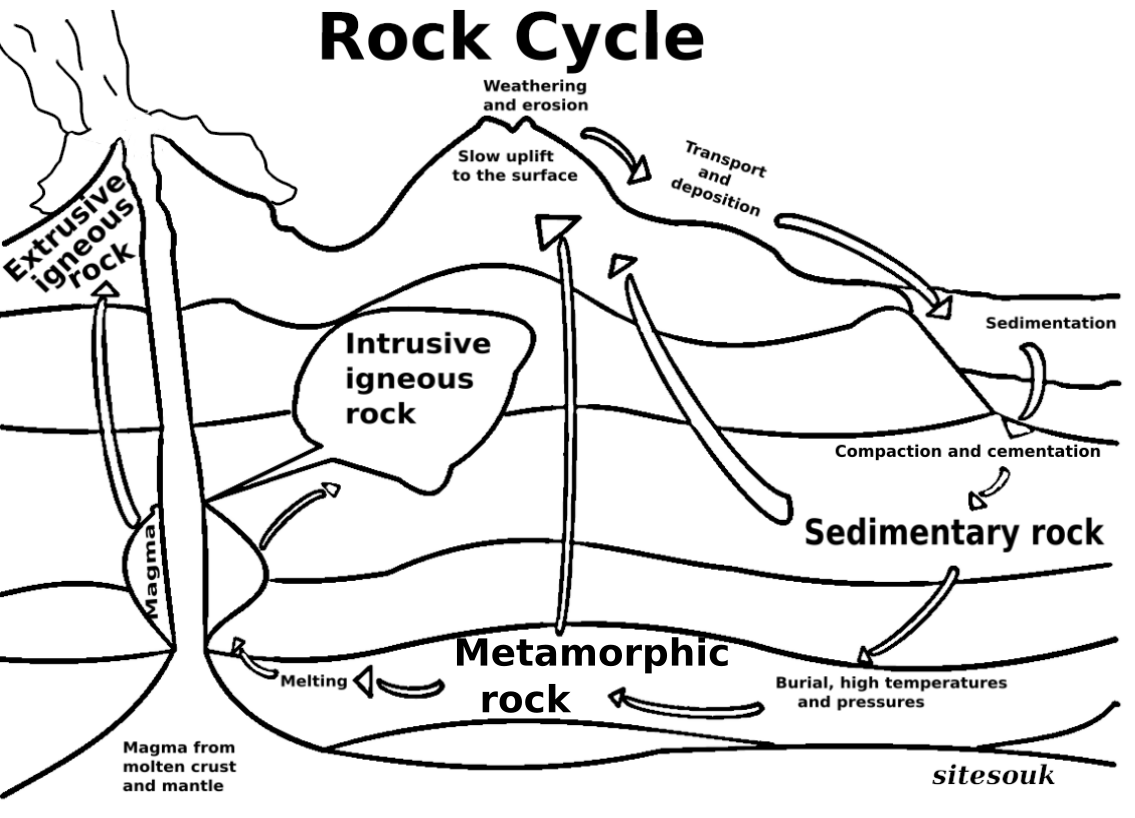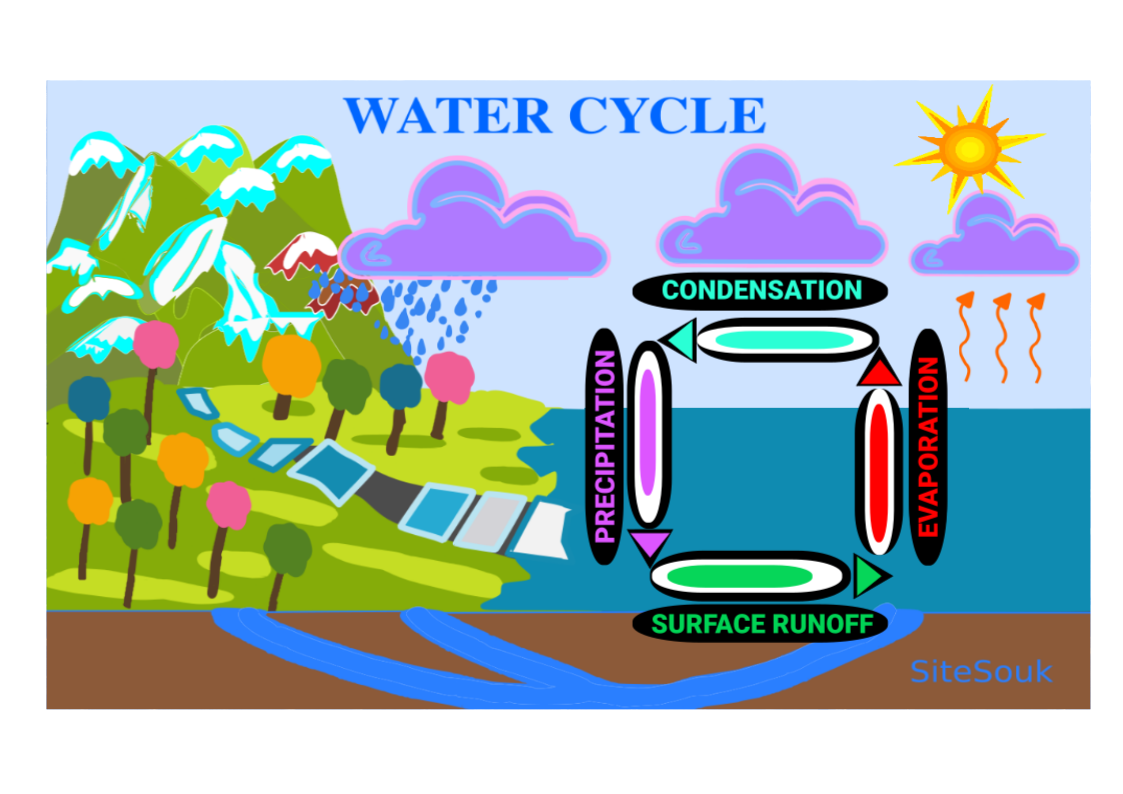Rock Cycle.

5th grade, 6th grade, 7th grade, 8th grade, Middle School.
The rock cycle is a continuous process of transformation of rocks from one type to another over long periods of time. It is driven by the processes of weathering, erosion, deposition, heat, and pressure. The rock cycle can be described in several stages:
- Igneous rocks are formed from magma or lava that cools and solidifies. This process is called solidification or crystallization.
- Weathering and erosion break down the igneous rocks into smaller particles that are carried away by wind, water, or ice.
- The sediments are deposited and become sedimentary rocks. These rocks are formed through the processes of compaction and cementation, which occur over millions of years.
- Heat and pressure from deep within the Earth can cause the sedimentary rocks to undergo metamorphism, changing their texture, mineralogy, and composition. The result is metamorphic rocks.
- If metamorphic rocks are subjected to high temperatures and pressures, they can melt and become magma once again. This magma can then cool and solidify into new igneous rocks, restarting the cycle.
The rock cycle is an ongoing process that can take millions of years to complete. It is driven by the Earth's internal heat and external processes, such as erosion and weathering, and is important for understanding the history and composition of the Earth's crust
Simple explanation:
The rock cycle is the continuous process of Earth's rock changing form and becoming new types of rock. The three main types of rock are igneous, metamorphic and sedimentary. Rock is classified as one of these types based on how it is formed.
Magma is molten rock mixture found below the Earth's surface, formed from partial melting of solid rocks. It is less dense than surrounding rocks and can rise to the surface, erupting as lava and ash. Magma composition varies by location and depth. It plays a crucial role in igneous rock formation and Earth's geological processes.
Igneous rock forms from solidified magma and can be classified into intrusive and extrusive types. It provides insights into the Earth's geologic history.
Metamorphic rock forms from existing rocks through heat, pressure, and chemical reactions, resulting in new rocks with unique properties that provide insights into the Earth's geological history.
Sediment is natural material broken down from rocks and organic matter through weathering, erosion, and transportation that can form sedimentary rocks and provide insights into the Earth's geological history.
Sedimentary rock forms from compacted and cemented sediment, with three main types: clastic, chemical, and organic. It provides valuable insights into the Earth's geological history.
Detail Explanation:
Magma is a molten rock substance that is located beneath the Earth's surface. It is formed by the melting of rocks due to the high temperature and pressure within the Earth's mantle. Magma can rise to the Earth's surface and become lava during volcanic eruptions, or it can solidify and cool beneath the surface to form igneous rocks.
Igneous rocks are formed through the cooling and solidification of magma or lava. They are classified into two types based on their mode of formation: intrusive igneous rocks and extrusive igneous rocks. Intrusive igneous rocks form when magma cools and solidifies slowly beneath the Earth's surface, while extrusive igneous rocks form when lava cools and solidifies quickly on the Earth's surface.
Examples of intrusive igneous rocks include granite, gabbro, and diorite, while examples of extrusive igneous rocks include basalt, andesite, and rhyolite. The properties and characteristics of igneous rocks are determined by the mineral content, texture, and cooling rate during their formation.
Metamorphic rock is a type of rock that forms from the transformation of existing rocks due to heat, pressure, and chemical reactions over time. These rocks are formed from pre-existing igneous, sedimentary, or other metamorphic rocks that are subjected to high temperatures and pressures deep beneath the Earth's surface.
Metamorphism can cause changes in the mineralogy, texture, and composition of rocks, resulting in the formation of new types of rocks with unique properties. Some examples of metamorphic rocks include marble, which is formed from limestone, and slate, which is formed from shale.
Metamorphic rocks are classified into two types: foliated and non-foliated. Foliated metamorphic rocks have a layered or banded appearance due to the alignment of minerals during the metamorphic process. Examples of foliated metamorphic rocks include slate, schist, and gneiss. Non-foliated metamorphic rocks, on the other hand, do not have a layered or banded appearance and are formed from rocks with a more uniform composition. Examples of non-foliated metamorphic rocks include marble and quartzite.
The properties of metamorphic rocks depend on the original rock's composition, the amount of pressure and heat applied, and the duration of the metamorphic process. Metamorphic rocks are important because they provide insights into the geological processes that have shaped the Earth's crust over time.
Sediment is a naturally occurring material that is broken down from rocks, minerals, and organic materials through weathering, erosion, and transportation by water, wind, or ice. Sediments can vary in size from large rocks to tiny particles of sand, silt, and clay.
When sediment accumulates and becomes compacted and cemented over time, it can form sedimentary rock. Sedimentary rocks are the most common type of rock on the Earth's surface, covering about 75% of the land. They are classified into three main types based on their mode of formation: clastic, chemical, and organic.
Clastic sedimentary rocks are formed from the accumulation of fragments of pre-existing rocks and minerals, such as sandstone and shale. Chemical sedimentary rocks are formed from the precipitation of minerals from solution, such as limestone and rock salt. Organic sedimentary rocks are formed from the accumulation of organic matter, such as coal and oil shale.
Sedimentary rocks can also provide clues about the environment and conditions in which they were formed. For example, fossils found in sedimentary rocks can help us understand the life forms that existed in the past, while the presence of ripple marks or cross-bedding can indicate the movement of water or wind.
Overall, sedimentary rocks and their composition provide a valuable record of Earth's history, climate changes, and geologic processes that have occurred over millions of years.
